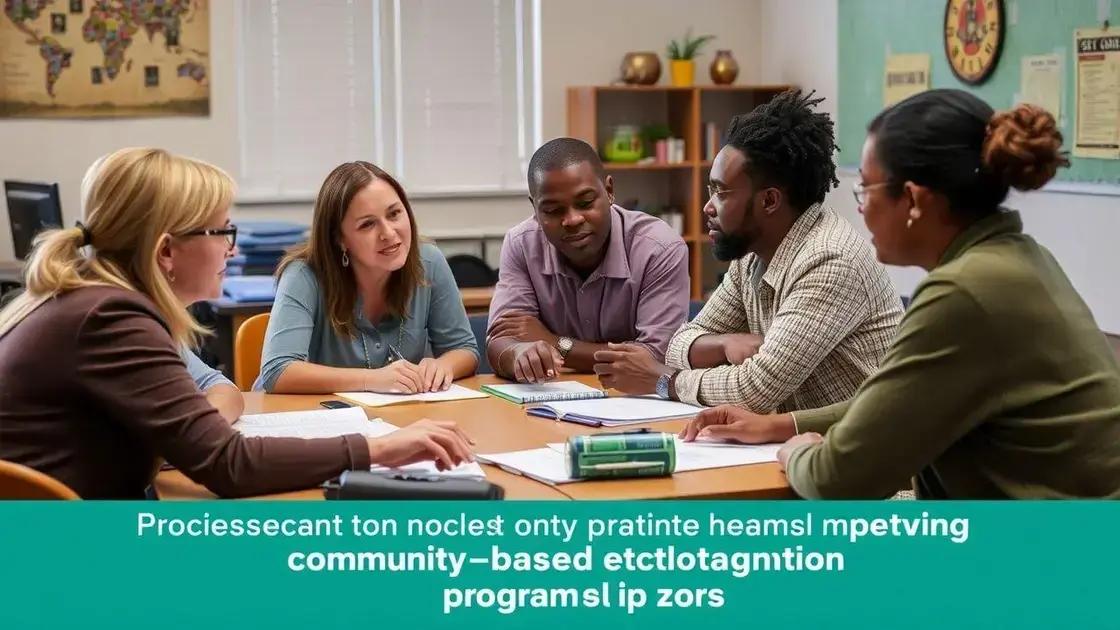Community-based education: Transforming learning together

Anúncios
Community-based education enhances learning by integrating local resources and partnerships into the curriculum, benefiting both students and educators through engaged, real-world experiences.
Community-based education is all about harnessing local resources to enrich the learning experience. Imagine learning in a setting that feels more like home than a classroom. Curious about how this impacts education? Let’s dive deeper.
Anúncios
Understanding community-based education
Understanding community-based education is essential for grasping how learning can transcend traditional classroom boundaries. This approach celebrates the unique resources of a community, turning them into enriching educational experiences.
This method encourages collaboration between local organizations, schools, and families, providing learners with more personalized and relevant education. Now, let’s explore some core aspects of how community-based education functions.
Anúncios
Main Components of Community-Based Education
The effectiveness of community-based education relies on several key components:
- Local Partnerships: Schools collaborate with local businesses, non-profits, and community groups.
- Real-World Learning: Students engage in projects that are relevant to their community.
- Inclusive Environment: Education is accessible to all community members, promoting diversity.
- Shared Goals: Everyone works together towards common educational objectives.
These components create a network of support that benefits both students and educators. This practice also fosters a sense of belonging and ownership in the educational journey.
Engaging with local experts and using community resources not only makes learning more relevant but also bridges the gap between school and life experiences. For instance, students might work on a project that involves collaborating with local artists or environmental groups. This involvement can spark interests that may influence career paths.
Impact on Student Learning
The impact on student learning can be profound. By participating in community-based education, students often show improved motivation and a deeper understanding of their subjects. They feel more connected to what they are learning, as it directly relates to their surroundings. Students also develop vital skills such as teamwork, communication, and problem-solving.
Moreover, this educational approach encourages critical thinking. By solving real-world problems, students learn to ask questions and consider different perspectives. For example, while working on an environmental project, they might analyze local pollution levels and respond by forming campaigns to address the issue.
Community-based education is more than just a learning strategy; it’s an opportunity to enrich lives and enhance communities. As we delve deeper into this transformative approach, it’s evident that such collaborative efforts can lead to positive change both inside and outside the classroom.
Benefits for students and educators
Benefits for students and educators are numerous when engaging in community-based education. This educational approach fosters meaningful connections and provides unique opportunities for learning.
One major advantage for students is the practical experience they gain. When students participate in real-world projects, they can apply their knowledge and skills in a hands-on way. This not only boosts their confidence but also enhances their understanding of the subjects.
Benefits for Students
Community-based education allows students to:
- Enhance Critical Thinking: Engaging with real challenges encourages students to think critically and develop problem-solving skills.
- Strengthen Social Skills: Working with others in community projects improves communication and collaboration, essential skills for future success.
- Explore Career Paths: Exposure to local professionals gives students insights into different careers and industries, helping them make informed decisions.
- Build Resilience: Facing challenges and overcoming obstacles in community settings teaches students perseverance and grit.
These benefits create a more engaging learning environment, where students feel valued and motivated to learn.
Advantages for Educators
Educators also reap rewards from implementing community-based education. They can enjoy:
- Improved Relationships: Collaboration with local organizations fosters strong partnerships and networking.
- Access to Resources: Educators can tap into local expertise and materials, enriching classroom learning.
- Increased Engagement: Exciting and relevant projects keep both students and teachers enthusiastic about learning.
- Professional Growth: Working in community settings allows teachers to expand their skills and enhance their teaching practices.
By working closely with the community, educators can develop curricula that truly reflect students’ interests and needs, leading to a more impactful educational experience.
Overall, the mutual benefits for students and educators in community-based education create a cycle of learning and support that enhances the educational landscape.
Strategies for effective implementation

Strategies for effective implementation of community-based education are crucial for ensuring success. By using thoughtful approaches, educators can create enriching experiences that benefit students and the community alike.
One essential strategy is to establish strong partnerships with local organizations. Collaborating with businesses and community groups allows resources to be shared, which enhances learning opportunities. Schools should reach out to community leaders to develop programs that make learning relevant and engaging.
Key Strategies for Implementation
Some effective strategies include:
- Curriculum Integration: Blend community resources into the curriculum to make lessons more engaging and practically relevant.
- Active Participation: Encourage students to play a role in planning and executing community projects, fostering ownership of their learning.
- Regular Feedback: Have ongoing communication with community partners and students to assess the effectiveness of initiatives and make necessary adjustments.
- Training for Educators: Provide teachers with professional development that focuses on community engagement strategies and how to facilitate projects effectively.
Implementing these strategies helps create a more dynamic educational environment where students feel more connected to their learning. Additionally, using local resources leads to more contextual learning, making education relatable and impactful.
Another vital strategy is to ensure that the projects align with community needs. Conducting surveys or holding meetings can help identify pressing issues the community faces. When students work on real-life problems, they see the impact of their efforts, making their learning journey even more meaningful.
Flexibility is also important in this implementation process. Educators should be ready to adapt plans as projects evolve. This adaptability ensures that the educational experience remains relevant to students’ and community needs. By focusing on actionable strategies, schools can create robust frameworks that support community-based education.
Challenges of community-based education
Challenges of community-based education can impact its effectiveness and sustainability. While this approach offers numerous benefits, it also presents obstacles for educators and students alike.
One significant challenge is coordinating with various community partners. Each group may have different goals, timelines, and resources. This complexity can lead to misunderstandings and conflicts. Clear communication and defined roles are essential to minimize these issues.
Common Challenges
Some of the most common challenges include:
- Lack of Resources: Not all communities have the necessary materials or funding to support comprehensive educational projects.
- Time Constraints: Students and educators often struggle to balance community projects with standard curricula and responsibilities.
- Training Needs: Educators may require additional training to effectively facilitate community-based projects.
- Community Engagement: Gaining and maintaining community involvement can be difficult, especially if stakeholders do not see immediate benefits.
These challenges can hinder the successful implementation of community-based education but can often be addressed with proper planning. For example, establishing regular meetings can help ensure that all partners remain aligned. Furthermore, investing in teacher training programs can equip educators with the skills needed to navigate these complexities.
Another hurdle can be evaluating the effectiveness of community-based initiatives. Traditional assessment methods may not capture the full impact of experiential learning. Adapting evaluation methods to reflect real-world outcomes is crucial for understanding the benefits of these projects.
Despite these challenges, overcoming them can lead to stronger partnerships and more impactful educational experiences. By recognizing and addressing the hurdles of community-based education, educators can create lasting transformations in learning environments. Thus, it becomes essential to view these challenges as opportunities for growth and innovation.
Examples of successful initiatives
Examples of successful initiatives in community-based education showcase the potential of this approach to enhance student learning and community engagement. By examining these examples, we can see how effective strategies can lead to positive outcomes.
One impressive initiative is the Community Gardening Project in which students learn about sustainability and healthy eating. Schools partner with local farmers to create gardens where students grow vegetables. This hands-on experience teaches important lessons about nutrition and environmental stewardship while promoting teamwork.
Successful Community Programs
Some notable examples include:
- Reading Partners: This program pairs students with community volunteers who help them improve their literacy skills through personalized reading sessions.
- Coding Bootcamps: Local tech companies offer after-school programs to teach students coding skills. This initiative prepares them for high-demand careers while fostering interest in technology.
- Art in the Park: Schools collaborate with local artists to create mural projects. This not only beautifies the community but also allows students to express their creativity and learn about art.
- Cultural Exchange Programs: Schools connect with international partners to provide students with cultural experiences through virtual exchanges, enhancing global awareness.
These successful initiatives highlight the diverse ways in which community-based education can thrive. They demonstrate that with collaboration, creativity, and commitment, schools can positively impact their communities while enriching student experiences.
Such projects often result in high levels of student engagement. When students see the real-world application of their learning, they become more motivated. Additionally, these initiatives foster a sense of belonging and pride in their communities.
These examples represent just a few of the transformational opportunities that community-based education can offer. Are you ready to explore how such initiatives can be implemented in your own community? They can make a lasting difference in the lives of students and the community as a whole.
FAQ – Frequently Asked Questions about Community-Based Education
What is community-based education?
Community-based education is an approach that incorporates local resources and partnerships into the learning process, enhancing relevance and engagement for students.
What are some benefits of community-based education for students?
Students gain hands-on experience, improved critical thinking skills, and a greater sense of connection to their learning by participating in community projects.
How can schools successfully implement community-based education?
Schools can implement this approach by establishing strong partnerships with local organizations, integrating community resources into the curriculum, and actively involving students in planning projects.
What challenges might arise with community-based education?
Challenges can include coordinating with various stakeholders, lack of resources, and maintaining community engagement, but these can often be addressed with clear communication and adaptability.






